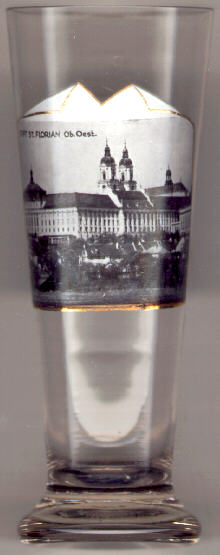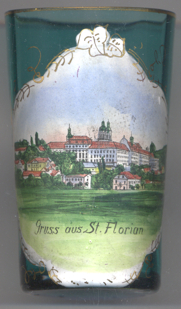

|
| ÖSTERREICH | AUSTRIA |
| Bundesland: Oberösterreich | Upper Austria |
| Bezirk: Linz-Land |
 Sankt Florian developed at the legendary burial place of St. Florian who died in AD 304 as a martyr
at the nearby roman town of Lauriacum (Lorch, today part of Enns).
The first documented mentioning dates from AD 823 and refers to a cellula, a small monastery.
Another document of 888 already refers to a monasterium, a larger monastery.
Since 1493, Sankt Florian has the status of a market town.
Sankt Florian developed at the legendary burial place of St. Florian who died in AD 304 as a martyr
at the nearby roman town of Lauriacum (Lorch, today part of Enns).
The first documented mentioning dates from AD 823 and refers to a cellula, a small monastery.
Another document of 888 already refers to a monasterium, a larger monastery.
Since 1493, Sankt Florian has the status of a market town.

The  monastery already existed in Karolingian times (about AD 800),
the crypt dates back to the pre-Romanesque and Romanesque period.
Since 1071 it is a monastery of Augustinian Canons.
According to the legend, the monastery church was erected over the tomb of St. Florian.
The core of the building dates from the Gothic period, but archelogical investigations
prove an uninterrupted series of structures going back to Roman times.
The present Baroque church dates from 1686–1708 and is the chief work of the architect
Carlo Antonio Carlone. The monastery buildings were finished by Jakob Prandtauer in 1751.
The library of the monastery was built 1744–1750 by Johann Gotthard Hayberger
and contains about 130,000 volumes, 809 manuscripts and 800 early prints.
The church received the papal title of a Basilica minor in 1999.
monastery already existed in Karolingian times (about AD 800),
the crypt dates back to the pre-Romanesque and Romanesque period.
Since 1071 it is a monastery of Augustinian Canons.
According to the legend, the monastery church was erected over the tomb of St. Florian.
The core of the building dates from the Gothic period, but archelogical investigations
prove an uninterrupted series of structures going back to Roman times.
The present Baroque church dates from 1686–1708 and is the chief work of the architect
Carlo Antonio Carlone. The monastery buildings were finished by Jakob Prandtauer in 1751.
The library of the monastery was built 1744–1750 by Johann Gotthard Hayberger
and contains about 130,000 volumes, 809 manuscripts and 800 early prints.
The church received the papal title of a Basilica minor in 1999.
(see also list of other basilicae minores depicted on glasses of this collection)
 Anton BRUCKNER (b. 1824 in Ansfelden, d. 1896 in Vienna),
one of the greatest Austrian composers of the 19th century, was organist in the
abbey church from 1848 until 1855. The famous organ on which he played was built 1770–1774 by
Franz X. Chrisman from Ljubljana/Laibach. It has
7343 pipes and 103 stops. According to his wish, Bruckner was buried in a vault
underneath the organ. Since 1930 the organ bears the name 'Bruckner-Orgel'.
Anton BRUCKNER (b. 1824 in Ansfelden, d. 1896 in Vienna),
one of the greatest Austrian composers of the 19th century, was organist in the
abbey church from 1848 until 1855. The famous organ on which he played was built 1770–1774 by
Franz X. Chrisman from Ljubljana/Laibach. It has
7343 pipes and 103 stops. According to his wish, Bruckner was buried in a vault
underneath the organ. Since 1930 the organ bears the name 'Bruckner-Orgel'.
![[scale]](lineal.jpg)